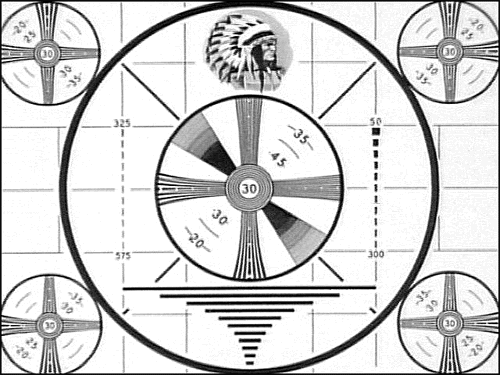June 25, 2020
AIR.CAT L'ENTREMIG
My partners Gerry Smulevich and Alberto Barcia Fernández and I had to postpone our planned AIR.CAT summer artist residency program. We are going to do some interesting things in the meantime...
AIR.CAT Press Release, Summer 2020Due to worldwide travel limitations imposed by the COVID19 pandemic, AIR.CAT (Artist in Residency, Catalunya) has been forced to postpone its planned Summer 2020 artist residency program for next year, Summer 2021.
AIR.CAT is an artist residency program based in Tossa de Mar whose mission is to bring artists from around the world to Costa Brava to learn about Catalunya and the special character and history of Tossa de Mar, make art and exhibit their work in Tossa's Municipal Art Museum, the first contemporary art museum in Spain. Tossa was the destination of international artists who sought refuge from the turmoil of war in the 20th century. In those years, artists such as Marc Chagall, André Masson, Georges Bataille, Oscar Zügel, Otho Lloyd and Dora Maar and many others lived and created and exhibited art in the seaside town of Tossa. AIR.CAT's ambition is to restore Tossa as a destination for active contemporary artists.
Rafael Benet called Tossa the "Babel of the Arts" and since then this phrase has been proudly adopted by Tossa to convey this special distinction. AIR.CAT seeks to reinvigorate the spirit of this distinctive identity with a yearly recurring flow of artists who will have the opportunity and time to reflect on contemporary issues that preoccupy the international art world. The four-week program will expose these artists to the artistic treasures of Catalunya with field trips to Barcelona, Girona, and the Empuries. Tossa de Mar has several dimensions of natural wonders that the artists will explore such as hiking, kayaking the coastline and exploring the undersea world of the coastal Mediterranean.
Since AIR.CAT can't bring the six selected artists of the summer 2020 program to Tossa, we have decided instead to bring Tossa to the artists!. In a monthly virtual meeting, various personalities from Tossa will be introduced and interviewed in a group online chat that will be recorded and archived for future reference. People such as local representatives of the Ajuntament, builders of historic architecture, historians, chefs, archeologists, and many others will share with the six artists their experiences and offer insights into the special character of Tossa de Mar and Catalan culture. With this exceptional circumstance of postponement, we hope to "turn lemons into lemonade" and take the opportunity to enrich next year's participating artists with a deeper understanding of Catalunya that is certain to deliver a richer and rather special summer program for 2021.
June 13, 2020
ReZumthoring LACMA
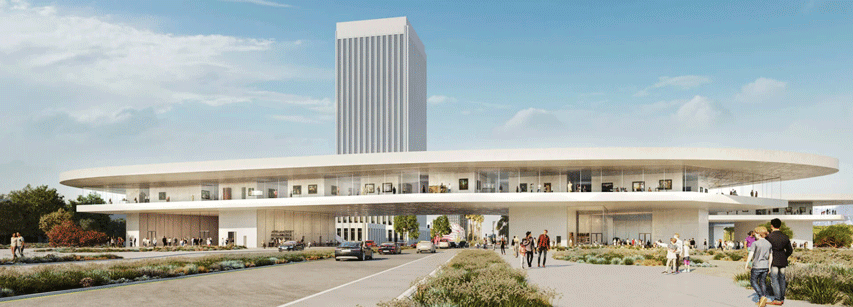
During the pandemic lockdown, news began to filter about a quiet demolition of historic elements of the LACMA campus:
In April, while all but the most essential workers were home under shelter-in-place orders, demolition crews began tearing down the three structures by LA modernist architect William Pereira that were part of the original 1965 scheme, as well as the never-loved 1986 addition by Hardy Holzman Pfeiffer Associates. As of last week, the museum's Bing Theater reduced to a pile of debris.Now, these aren't such stellar historic structures, iconic civic jewels such as the Tower Records building or Union Station or the Hollywood sign, even. It's inevitable to wonder if there wasn't a softer option for its director Michael Govan. Charting the way forward for one of Los Angeles' premier art museums is tricky business. Consider the numbers and general situation. The Pereira building needed asbestos abatement, which is a monumental exercise. It's of a scale that itself would provoke a complete demolition and redesign to follow in suit, instead of renovating the shell of a building that remains after that process. A classic good money after bad.
Even before the construction crews enter the campus, LACMA was already staggering $443 million in total debt. Imagine if you were the director facing this situation and charged with charting a path forward. Apparently, Govan's solution is to build an epic design of a replacement building, of such star power that could attract enough contributions in fund raising to overpower the liabilities and cost of construction. Easy, right? Not so fast, architecture will take you to the limit, in patience, temper and budget, it always does. Preliminary cost estimates range between $650-750 million. The final numbers always dwarf the preliminaries, I'd say that planning on double the initial estimate is a rational frame of mind in almost any architectural project. We're in the well over a billion territory and counting.
[Jump cut to Howard Ratner in Uncut Gems. Most of the ruling class must be exactly like that character.]
So, the gamble is a billion and change in dollars. Maybe two. As the director, you have to find an architect to pull it off. Govan chose Peter Zumthor, not the most well known name at the time of the choosing. An exquisite sensibility. He is well respected in architectural circles for projects that were tiny in comparison to what is about to go down in Los Angeles' Miracle Mile, smack dab within the La Brea Tar Pits. What ominousness overtones! LA's boom and bust Day of the Locust and "It's Chinatown, Jake." Miracles, indeed. And pools of upwelling crude that have drowned struggling creatures for millennia. The whole prospect is as scary as it is enticing.
Cat nip for architects.
Cutting to the quick here, my critique is that Zumthor delivered a lazy cartoon. I think that LACMA is better off left as it is for the time being... for this generation at least. The asbestos is best left undisturbed until LACMA pays off existing debt and stores up enough energy to take on the ultimate obligation of rebuilding itself. But Govan pulled the Cortez option, there's no turning back now.
If you're going to revamp the exhibition program, then try to swing for the bandstands. If you're going to make an icon of the tar pits, don't extrude a doodle. From the g-d's eye view of an architect standing over a plan, Zumthor drew an outline of a pool of liquid and initially colored it black. Levitate the squiggle a couple of stories over the site to evade the problematic sticky ground plane, extrude and BOOM, you have a world class museum to pull off in LA what Gehry did in Bilbao.After the phenomenal success of Gehry's design for the Guggenheim Museum in Bilbao, Spain, critics began referring to the economic and cultural revitalization of cities through iconic, innovative architecture as the "Bilbao effect". In the first 12 months after the museum was opened, an estimated US$160 million were added to the Basque economy. Indeed, over $3.5 billion has been added to the Basque economy since the building opened. In subsequent years there have been many attempts to replicate this effect through large-scale eye-catching architectural commissions that have been both successful and unsuccessful.
A Bilbao Effect is a flash which is destined to fade as the world rushes to imitate in diminishing resonance. The Big Bang and Heat Death over and over again, turtles all the way down. Contextual circumstances are instructive. Bilbao was challenged with shifting from a declining shipping industry to another better horizon. Tourism in Spain garners between 12-25% of their GDP and the decision to choose a starchitect to reestablish Bilbao on a cultural tourism industry made a lot of sense. The sensibility, history, and European context of the Basque people and post-Franco Spain was a most unique context. It takes more than an architect superhero to pull off another Bilbao Effect.
A constellation of factors aside, let's examine LACMA's new design. Zumthor's elevated planar squiggle forced the program into a tightening lasso.
...announcements by Michael Govan, director of the Los Angeles County Museum of Art, were always reassuring: don't worry, the new structure replacing the four existing gallery buildings on the East Campus would equal their total square footage, though the gallery space might be a wee bit smaller.A single floor, the design relied on an undulating glassed perimeter which imposed huge limitations on the exhibition program. Art work must be arrested in time and entropy and even ambient indirect sunshine is a conservator's ulcer, limiting what can be shown on the walls, that are all facing a view that over-competes for the visitor's attention. Light controlled exhibition environments are the square footed remains of the plan minus the corridor belt, the "nucleus of the cell", as it were. Add to the list of constraints, the thickness of the plane itself, in compliance with the extruded puddle doodle, a uniform ceiling height regimenting all exhibition spaces.Then the bombshell exploded: the Final Environmental Impact Report (EIR) released in late March slapped Angelenos to attention when they learned they would be paying $650 million to get a building that would be 105,108 square feet smaller than the originals, with 53,000 square feet less gallery space.
All of these issues are not-so-insignificant irritants, but the biggest has to be fact that it will be a smaller building than the one it will replace. How to deal with this shortcoming? To increase the performance of a museum gallery, we can't use a turbo charging concept since super-compressing a volume of people is inhumane and a travesty to art. Instead, the idea is to overclock the exhibition schedule, speed up the rotation of exhibitions and flow more people through the turnstiles. This reminds me of what happened in fashion in the past thirty years where the yearly season cycle went from four to five to -fast forward- past twelve. The effect on the fashion industry? It's called "Just-in-Time" design and manufacturing, a hamster wheel from hell where creativity is shrunk to the limbic and the twitch response is amplified fearfully. Map what happened in fashion's design offices to what will happen to LACMA's curatorial offices, if you will.
This is becoming a tirade of a critique... but hey! I'm just getting started.
Both Peter Zumthor's LACMA and Richard Meier's Getty Museum share something in common. Both faced pressure form their clients to fundamentally subvert their designs. (I will leave the question as to whether their careers were subverted, like a loaded pistol on a tabletop.) Meier's entire oeuvre up until the Getty project was based on an architectural dictionary derived from Le Corbusier's Villa Savoye. In 1920, Corbusier published Toward an Architecture, unleashing his famous quote "Une maison est une machine-à-habiter" ("A house is a machine for living in"). Meier made an architectural canon from this, a catalog of machine components recombined into a career of projects which branded him quite effectively. When the day came that Meier's Getty clients insisted on a switch out from his typical white anodized modular metal exterior cladding, he should have smiled and said no. Yes, like Roark did... and not particularly for Randian reasons... but yeah, like that. The same goes for Zumthor, who was asked to switch out the initial bitumen black finish he first envisioned for... what I imagine he thought was something more SoCal: desert beige. (SoCal is a multitude of microclimates, actually.) You see, the only quality that could have possibly allowed his doodle to fly was an inky petrochemical blackness, which should have been everywhere, maybe even inside the galleries and parking garages, the sun and the world be damned. But no. This was not to be. The color change, doubly untethered to the subterranean tar pit site of inspiration, sent associations to other places... to the freeway overpasses, unfortunately.
So, what to do?
Well, I can imagine an alternate future. What if we could go back in time after the Govan meet up, when the roll of tracing paper first laid over the site plan? What if we ReZumthored LACMA?
Let's do it.
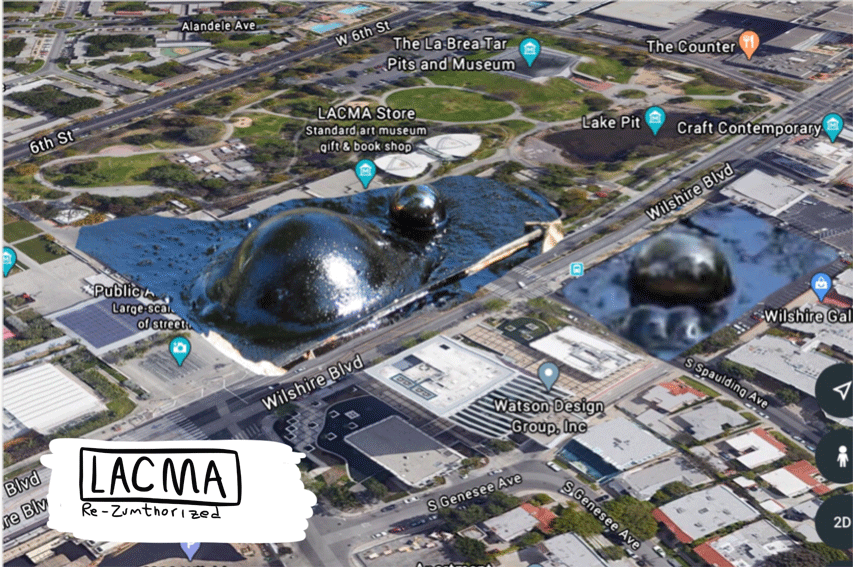
Ladies and gentlemen and everyone in between, I present an alternative LACMA design. The allure of the tar pits is too strong, sending us towards an allusion of the art world itself. Quicksand and sticky bitumen of oblivion, the pickled archive of mother nature as the ultimate conservator, the upwelling of memory, levitating gasses of curation, entropic time arrested, a nearly combustive atmosphere of curatorial swamp gas... There his no way to go in reference to this mother load of contextual associations but directly into eye of the hurricane of verisimilitude. Abstract any distance less and the result would be Just Pathetic.
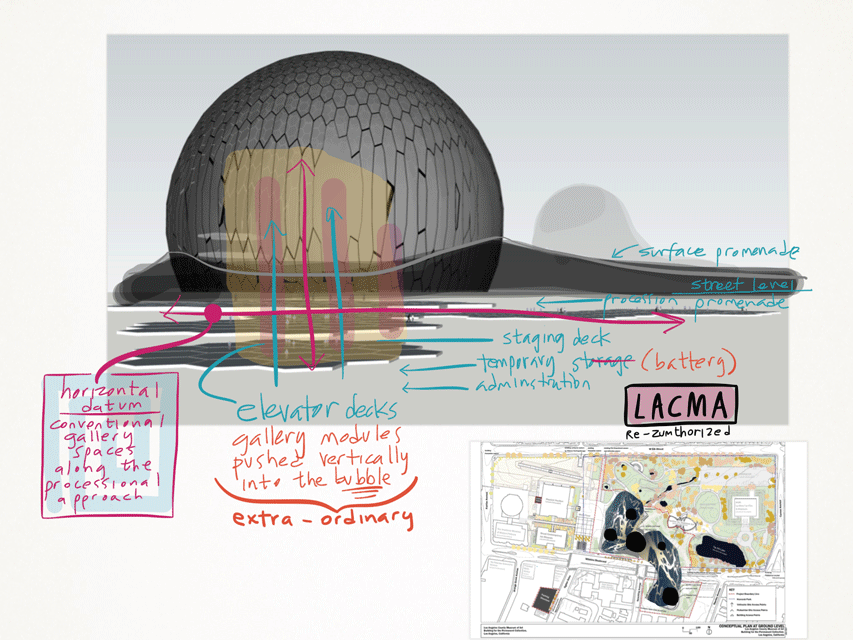
Let's use the Bilbao Effect. Let's employ the eye catching star of the show main exhibition space and express it as a machine for showing art in. Go for it, a
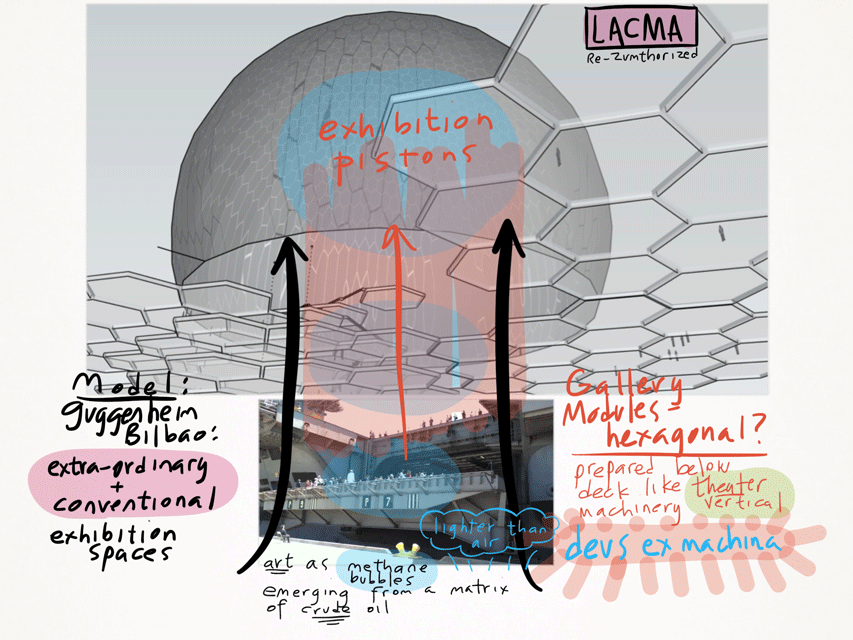
The parti for the ReZumthor is geometrically roughly similar, except that there are multiple nodes, one centrally large with smaller satellite exhibition spaces in the surround. Instead of a material accident, drainage. Rectilinear galleries framing double loaded irregular corridors all trickling towards the sinkhole where art erupts. The procession in circulation spaces are slippery meandering rivulets trickling towards a simultaneous burbling drain and upwelling source. All this beneath a bulbous bituminous integument. A shimmering oleaginous membrane, swollen with imaginative surprise.
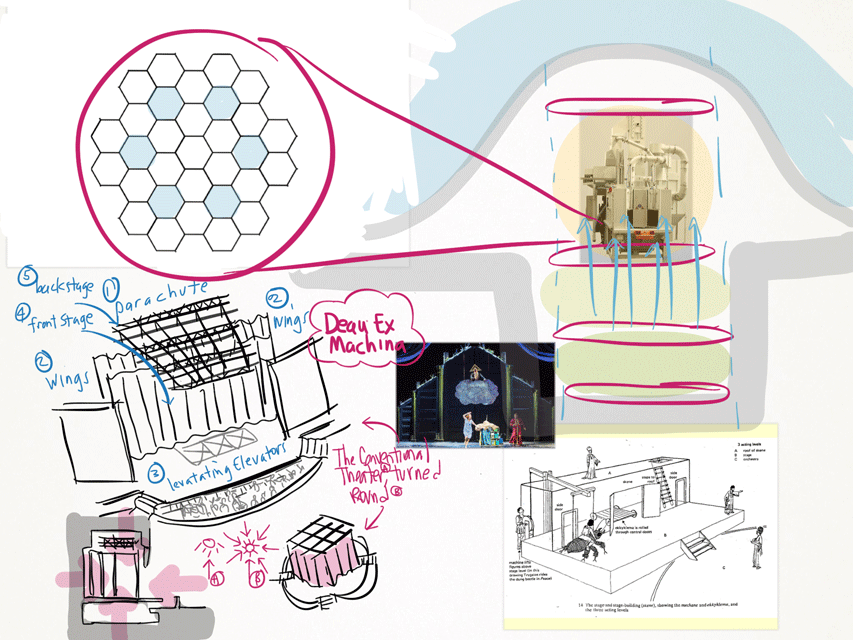
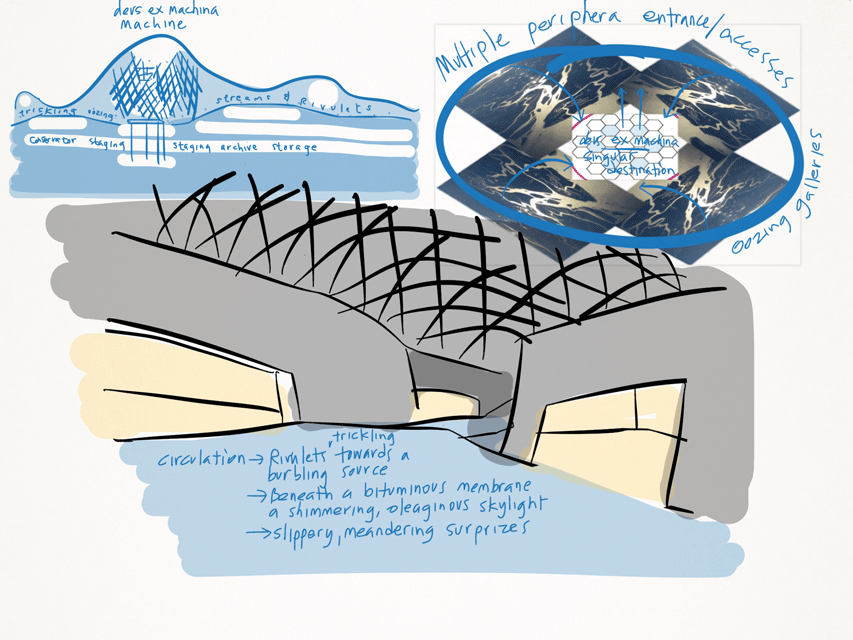
Via Ben Davis:
In the 1966 essay on "The Historical Function of the Museum," the art critic John Berger recounted a scheme proposed by an unnamed "French curator" in a then-recent book. "[T]he museum of the future will be mechanized: the visitors will sit still in little viewing boxes and the canvases will appear before them on a kind of vertical escalator. 'In this way [the curator wrote], in one hour and a half, a thousand visitors will be able to see a thousand paintings without leaving their seats.'"
June 11, 2020
Art: Pro-Practice
Last Spring, I received an email request from a friend:
I am writing to you because I am teaching a Painting MFA seminar here at [XXXX} University this semester centered on exploring issues of "art context" and "art mediation." Part of our class time is dedicated to interviewing different people that work in different roles as agents or actors in the for the lack of a better term "art world" to try to see things from their point of view. The idea is to try to discern the complexity of the value systems, networks, and social dynamics in which art practices are inserted. We have interviewed artists, docents, curators, writers, art historians, etc.
I thought about inviting you to join us for a conversation.
We used to call this topic "Pro Practice" back in my day. This is a grad seminar designed to prepare young artists for the world they are about to embark. After the Zoom talk, I pulled much of the conversation into the notes below and elaborated a bit more. My abiding theme was a description of two worlds: the real idealistic world and the unreal realistic world.
The former is about a fidelity to inspiration, creativity and the courage to accept the consequences of the hazards of wider audience receptivity, to reconcile oneself with oblivion, to simultaneously steel oneself against it by striving to create art objects that survive dissolution by a demonstrable self evident value that resists the destiny of the landfill. The latter is about an ecosystem of egos operating within an economic marketplace that has in recent years become more and more corporatized and bureaucratized despite the erosion of modern late Industrial Revolutionary disruptive innovations.
Promises of SuccessArt schools have been suffering under the pressure to promise at least some degree of career success when graduates sally forth into the world. The truth is, no one knows. Two forces run sometimes in concert and sometimes counter to each other: one advances the historical argument and summons with universal acclaim, beautiful surprise; the other is akin to chance molecular connections of entities in Brownian motion. Maybe something like a Darwinian survival of the fittest brings the fittest art to the world stage. Maybe greatness would lie hidden in plain sight, undetected until oblivion erases all traces from human memory. The best an artist can do is to strive, to summon the superlative from the core of their being... and then allow their reverberation to travel via the medium of the art community at large. The rest is destiny.
The list of the particulars concerning the marketplace that could be discussed in an art school setting but generally isn't: What is value and how does pricing art work? When is pricing real and when is it artificial? What is the business relationship between a gallery and an artist? What is the difference between a primary and secondary market? What is a contract, either implied or written? What is the history of art dealing, who are the major figures and how does character and circumstance shape their destiny? Similarly, what is the survey of the art city past and present, and how does historical circumstance shape them? How do the mechanics work between galleries, museums, critics, art fairs, etc? How can the art system be gamed? What different kinds of collectors are there, what motivates them? What is money laundering and what are the signs? If art is sold depending on perceived prestige, how is is prestige created, grown, simulated and/or destroyed? This is a list that I can whip out in a single sitting. Young artists who leave school unequipped with this compass are easy prey.
Don't let them know you're hungry. Back in the early aughts, my gallery shared an exchange with another artist in the stable. The artist wanted to tell the gallery how much he needed them to sell his art work. If that wasn't bad enough, he relayed his concerns with such desperation that it shook the gallerist and not in a good way. It was then as I listened to this account that I resolved never to let a gallery know how hungry I was. We need our galleries to sell our work with confidence, conveying the sense of the value of our work to the collector. We don't need to hazard the seep of undertones of desperation to the world at large. Our confidence in the greatness of our work must be total and rooted in reality. Our survival is our own responsibility and can never be laid at the foot of the people who sell -or buy- our work.
Modeling the Art World
Art school is a virtual version of the art world, a necessarily simplified model. Art education is a schematic of a community of peers, a studio, opportunities to exhibit and gatekeepers in overwatch. The recent notion (growing within the art world for the past twenty or more years now) that artists can and should emerge from school hot into the marketplace has been a catastrophe for wisdom, common sense and a sensible art world. What is inevitably missing are the dimensions of the dialog in print (criticism) , the participation of collectors, the intermediary of the gallery and the ecosystem of the marketplace. This is true for all education, for all careers: a diploma marks only the beginning of an education. No art school can guarantee success nor make any promise in the direction of art career success, much less survival.
Realm of artist communities in collaboration... the loamy soil. Circles and circles of friends: real, strong and reverberating. The Aether of the social. The medium of friendship is where the expanding waves of the energy of influence moves. It wouldn't hurt to look up waves in the scientific sense in Wikipedia for interesting metaphors for the various dynamics of camaraderie. Being a service to the community is universally appreciated. Visit studios and talk about the work more than you talk about career. Curate your friends into a show. (Beware of ingratiatingly including yourself, it's a bad look.) Write a review. Band together with friends and open your own space. Don't get preoccupied with finding where the best party is in town. Have your own party. Be attractive, unforced. Get to know the history of artist friendship and rivalry. Like the Athens of Pericles, sometimes we find ourselves in the company of a group of brilliant people. Kismet. What do you do when this happens? What do you do when it doesn't?
Art and Value
The nature of art and the market. We operate within a marketplace but we are not OF the marketplace. The framework undergirding this arrangement is the distinction and relation between implicit and explicit value. Objects that are traded in the marketplace are vested with value in subjective and objective terms. Commodities (water, food, fuel...) and services have value that is easily formulated and calculated. Beauty is intangible and sensed differently in each and every mind. Commodities such as a refreshing beverage begin their existence explicitly in value and can arrive possessing the implicit, subjective, iconic value of, say, Coca-Cola. Flip this script for beauty. Art of every type begins existence endowed with perceived value that is implicit in nature. The social machinery of perceived value is established at the origin of the creating artist and proceeds into world in successive expanding waves of acquaintance within a social medium. The art world is not something outside of you. It begins within you if you are an artist. Your success will be the measure of its' realization. The velocity and amplitude of this energy can arrive delivering a value that is explicitly demonstrable in terms of money. The value of art, whether it's in the primary market of an emerging artist or the secondary market of an auction, depends on the degree that it is regarded as priceless. Note the wink of irony in that jealous possession is overcome by the ratcheted offering of price. The highest price is fetched by that which is mostly-yet-nearly impossible to be parted with. A conquest of fidelity. A stolen romance. An orgasm of seduction.
Structure of the Art System
There are artists who make art and gatekeepers who interlock into the architecture of the art system. Let's take a look at the components.
Collectors. They complete us. But too many today don't collect like they used to do, like artists making art. Too many rely on art advisors. Too many think of art as a fungible form of money. Once in a while, you could encounter someone who loves your art work as much as you do and will want to keep it near, to let others know you regard it as priceless. The jealous regard of pricelessness is the prize... this is what fetches the highest price.
Commercial galleries. The world of the gallerist is extremely tough, high stakes, so have some compassion for the honest ones. They come in sizes small, medium and large. Anyone could create a gallery, but do it for enough time, survive and thrive and this stability delivers them to the second category. The prize is access to the circles of elite collectors whose passion rivals that of the best artists. This schema is not as simple as it seems, and the gallery world can be a step through the Looking Glass. The problems that galleries have to contend with include managing rapid flows of income and outflows of expenses, retaining the investment in artist careers in the face of pressures on artists to migrate to stronger galleries who may or may not offer a stronger potential marketplace of passionate collectors. How does an artist gain gallery representation? This is like the question: how does a person fall in love? The answer is simple: you become fetching and available. The earlier discussion of the medium of friendship is important here. This is how a gallery gets to hear about you, through other people. Let that happen. Make this easy to happen. The game: garnering the trust of collectors beyond the periodicity of calendric time that could sustain a business economically. This is the measure of the strength of the "two list model" (my coinage): galleries have two lists. One is a list of collectors and what they want. The other is a list of artists and what they make. Are the correlations strong? Are they beyond enduring, do they grow?
There is of course a complex of institutions public and private. Every institution is an ecology of personality dynamics. Note the galleries who are tuned into that frequency. they owe their existence to the legacy of Alfred Barr, who created the model of curation and collection that endures to this day. Museum collections: every artist wants to be part of one but not everyone can get included. Museum curators: they see patterns in what artists make and present this to the world. Their popularization has weakened their power in recent years. Original thinkers among curators remain, but are hidden in the middling crowd. The silver lining when everyone wants to be a curator is that their visitations to the studio make them good honeybees of viral reputation transmission.
The art press is an institution in transition in this Information Age. Criticism, is it dead? When you think of a critic, try to characterize their creative contribution. Clement Greenberg ("Avant Garde and Kitch", Ab Ex) Raphael Rubenstein (Provisional Painting), Germano Celant (Arte Povera)... they're easy. Not so easy with most of the contemporary critics practicing today. The best critics are imaginative, perceptive, creative, peers of the best artists, in command of their craft of language. That their population is fewer today could be because of the dispersing force of the Information Age that has diluted their power and reach. They directed the force and concentration of prestige, who will take their place today, especially after the impact of the pandemic's social distancing when we can't witness the strength of the throng for ourselves?
Gaming the system
Every system gets gamed. Big system, big game. Small system , small game. Today's art world is a very BIG game. Don't game the system (else art becomes a cover for the real objective of power for its own sake)... but be aware of the games in play. The art world today is humongous, compared to its' nascent years when in one evening of gallery openings, you could meet ALL of the major players in the art scene. In the past, the population was small but the larger culture couldn't care less. Today, the danger is to be lost in the clamorous noise of our own making. The number of artists were smaller then and larger today but the population of true vision and talent has remained roughly the same. How to stand out from the crowd? By catering to dominant curatorial themes? Beware of art devolving into illustration.
The impact of the swollen Art Fair calendar has the overclocked art market. The art fair has existed since the beginning of modern art but it became what we know it to be today with the success of the Cologne Art Fair in the late 80's. Success breeds success as they say, but it does so ad nauseum. Like the California Gold Rush, seekers of fortune poured in by the droves, multiplying fairs to crowd the calendar, obligating galleries to support a road show that never stops, that never knows a break. Prices become goosed in this artificial environment, art only of a certain salable type gets shown and ultimately the population of collectors are gathered into one time, one place to the detriment of the conventional gallery ecosystem, starving them of their buying audience. Meanwhile, art fairs pin the gallery to the legacy model, preventing them from adapting to evolving circumstance by selecting galleries on the precondition that they occupy real estate and run a conventional program. Into this bind, they have in recent years started to undercut the curatorial function of the gallery by dictating what artists' work to exhibit in the fair. In this way and others, the art fair has evolved to an attenuated form where it starts to resemble processed food: hyped, overpriced and devoid of nutrition.
Artists can game the system by catering to its demands. The artless do this baldly, but the cunning can do it artfully. I call this "biting the hand the feeds you"... and this can be done via brute independence or in a false, theatrical manner, conforming to expectations. Examples of the former: Bruce Conner, Picasso, Carl Andre immediately come to mind. Some, more than a few, collectors love to demonstrate power by allowing themselves to be humiliated. Think of this as a taste for bitterness, the favor for "difficult" art. (*1) The kitten's ferocious gnaw. "If you can't be good, be notorious, right?" (a quote snatched on the fly from "The Eddy", Netflix series) History is a chronicle of bad behavior, art history even more so if every generation refusing the straitjacket of the previous is bad behavior. Independence is the most dangerous agent to any system. What happens when genius doesn't mitigate the asshole, when time doesn't tell, when theory blurs, when some players in the system find a way to game this aspect?
Staring Into the Abyss
Sometimes methods of survival are counter-intuitive. Steer into the skid. Relax when you are drowning. Similarly, it's wise to befriend oblivion. When we come out of school, we shoot for the hot out of the box success. The wunderkind. The prodigy. The genius newly emerged on the scene. If that doesn't manifest, we hope to be the discovery five years after graduation. "Hey, look over here!" The necessary gestation outside of academy's womb. If that doesn't manifest, we hope for that recognition after a ten year maturation. Then twenty. Then thirty. If that doesn't manifest, there's always the chastising "Hey, see the genius that we had overlooked!" If that doesn't manifest, there's the charitable indulgence of the octogenarian solo show. And if that doesn't manifest... we plan for posthumous recognition. Therefore, we must make art work that can argue -on its own power- for its sheer existence. Art after it is made, is in constant movement between the museum and the land fill. It might begin this journey in a living room, but it could move to a bedroom, hallway , closet or garage. It might be donated to a museum, but it's siting is not guaranteed. It might be hung on the walls for all to see, or it could go into storage or deaccessioned, and the cycle could possibly begin again. By befriending oblivion, you don't have to surrender to it. This reality instead can make you stronger, make your art stronger. The sheer acknowledgement of oblivion places it on a radar to be navigated, to be contended with. This, a contest no artist can evade.
*1: https://news.artnet.com/art-world/jordan-wolfson-documentary-spit-earth-1846551
Some Books:
Rogue's Gallery, a history of art dealing. The good, the bad and the ugly.
Duchamp, Man Ray and Picabia, a beautiful friendship.
Art Tribes, artist circles in and around 1968.
Bohemian Paris, artist circles in turn of the century Paris.
The Banquet Years, Roger Shattuck, more artist circles in turn of the century Paris. I came to love Alfred Jarry after this.
Leo and His Circle, The life of Leo Castelli by Annie Cohen-Solal, a tale of the emergence of the NYC art world.
June 10, 2020
the sheer idea of it
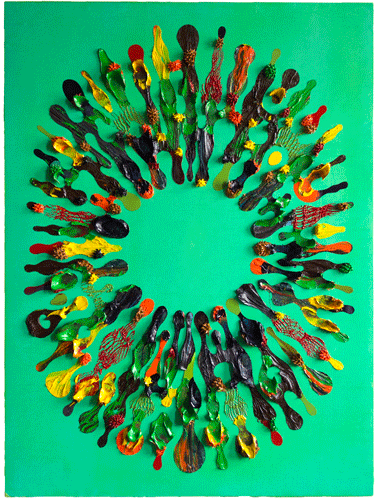
the sheer idea of it
2020
#596
40" x 36"
Oil and Acrylic on Canvas over Wood Panel
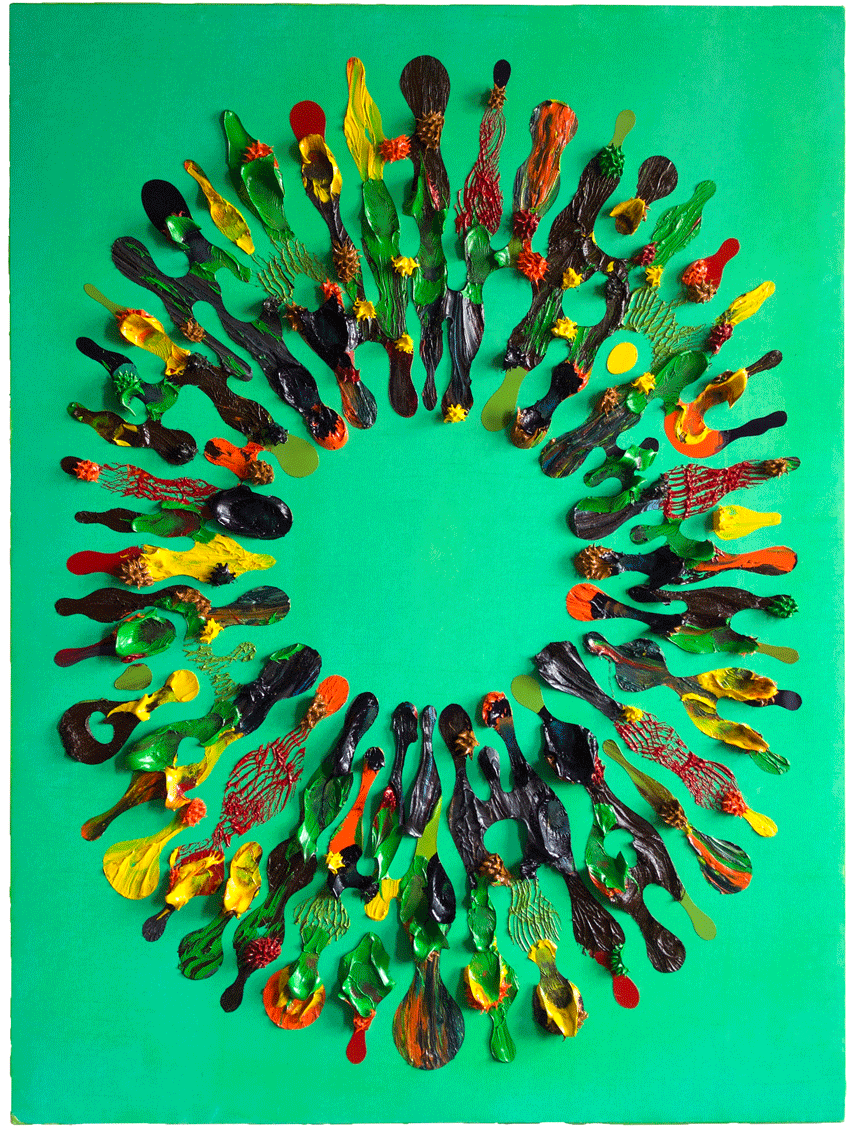
Art and Politics
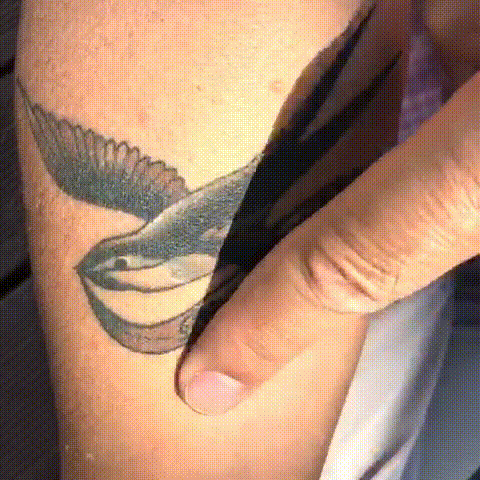
Art and politics are mutually exclusive realms. While art may care for politics, politics doesn't really give a damn about art. In the broad, diffuse, Aristotelian sense; man is / people are political animals because living together is an endless negotiation. But in the specifics of existence, politics is an expedient, it is strictly functional. Politics either does or does not deliver a live well lived. By contrast, art is another creature altogether.
Subject and medium are fundamental component aspects of art, and the torque of power between them is regulated by emotion. The range of feeling in existence is profound, reflected and refracted as it is between humans. It's calibrated to the cycles of planetary time and arcs of human life. Politics, by contrast, pursues specified objectives. Politics manipulates emotion towards its' own narrow purposes. Politics is automatically obliged to control art and this compulsion is never quenched. Politics is awash in emotion and seldom is it easy to discern the cynical from the genuine.
Poles Apart
One must be careful in the use of the political ordinates of right and left. There are nuanced differences across the Atlantic. In one sense, the Right and Left, the Communist Left and the Fascist Right, are socialist twins locked in an endless sibling rivalry. This chiral divide stems from the Tennis Court Oath in the French Revolution. The life they deliver is roughly the same, while the method of delivery varies. The former is distinguished by a common ownership of the means of production and a classless society. In the latter, a one party dictatorial government blends public and private economies and regiments the population. In Europe, a parliamentary democracy is the negotiating plane between these two political ordinates, Left and Right. However, as different the twins may be, both deliver roughly the same common civic product in socialist terms.
There are transatlantic commonalities, however. In another sense, the Right and Left represents the Conservative and Liberal. Closer to the normative definitions of these terms, the former is preoccupied with preserving accumulated wisdom from enduring social structures across generations. It wants to build onto to what was built before, to stand on the shoulders of giants, as Newton famously said. The latter yearns to be unconstrained, it is expansive and prefers to see the world anew, to be free of the sinews of history. Liberalism tends to ask the troubling questions, to transgress established boundaries, to yearn for what lies over the horizon.
The Constitution of the United States of America precedes the French Revolution and the European conceptualization of the Right and Left. The political DNA of the USA lies outside of the bipolar paradigm of the Continent. The Constitution was pragmatically engineered to resist tyranny via a governmental structure of checks and balances. As such, it makes no promises towards paradise, leaving that task to each citizen. And as such, it lies outside of the scope of the Continental orientation of Right and Left.
Wings.
Some wags like to tease those who choose the political center by saying that those who stand in the middle of the road will be run down. I have come to abhor both political extremes in any sense. I believe that the further one travels down either road, you arrive at an unquenchable lust for power, ideas be damned. I do believe that the center of gravity for the arts is to the Liberal Left since creativity requires the solvent of transgression for its initiation. But without access to the conserving instinct, the wisdom of generations are lost to us, and so creative pivot and balance must have access to that realm. It is the median territory that requires the most intellectual resources to manage its' dynamics. The center ground requires rationality, the space where we can reason things out, persuade one another. Empathy. Vulnerability. Compassion. Note that the root word within rationality is ratio, as in ratiocinate, to form judgements by the process of logic and reason. Through the awareness of contrast, consciousness arises.
Those who commit all to one side or the other merely flop around in circles, getting nowhere. Miasma. Disorientation. Dissolution. Unchecked, the loss of fulcrum renders one useless. The further you travel in either direction away from the center, the more one gets fenced in with cultish dogma. By the way, a cult is a group you can't leave without being inflicted with grave damage. Much like the cults such as Scientology, plumbing the ever deepening layers of dogma delivers you to the most absurd places, so much so that all reason must be abandoned and you are left prostrate to the idol of power.
Art and value.
Art isn't good merely because it is ardently political. Politics isn't good merely because it is artful. Art is its own sovereign realm. Art is emotion made concrete. Art history is charged with art movements that were generated by political preoccupations, and the argument that all that we do as asocial human being has political content. But politics is extremely temporal, contingent on the social dynamics of its' historical moment. Within this understanding, even the Mona Lisa possesses political content... but that painting is as enigmatic to us today as her smile. Politics is hard enough to understand in the moment of its' minting, and exponentially harder to comprehend in the grounding of its' truth the farther we are from the time of its' manifestation. Politics then, in this evaporative, evanescent state, disappears and the emotion remains for the ages.
It's hard to say what makes art good or great, and this is why it has an eternal aspect, linked as it is to human destiny. This is why the greatest art critics are poets, parsing as they do their subjects within their own parallel art form. Hippocrates aphorism Vīta brevis, ars longa has travelled some distance from the original meaning, but today's understanding has purchase still.
Politics is short, too.
***
Postscript:
A snip from a previous post bears repeating:
I know both worlds wherever they are. I love them. I know them all intimately. I know their shortcomings. I know just what kind of wretched they can be. I know them in their glory. I criticize them and defend them from each other. Civil war sickens me.
Postscript 2:
Gimbal.
That is all.
June 4, 2020
terrible, vengeful and merciless
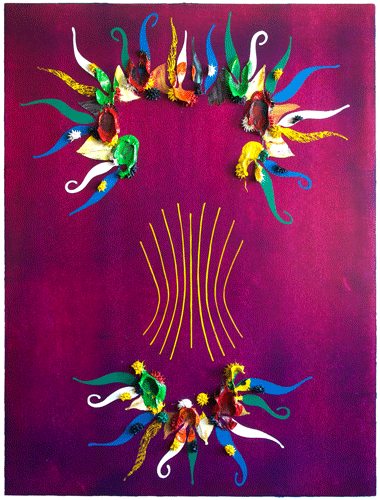
terrible, vengeful and merciless
2020
#595
48" x 36"
Oil on Canvas over Wood Panel
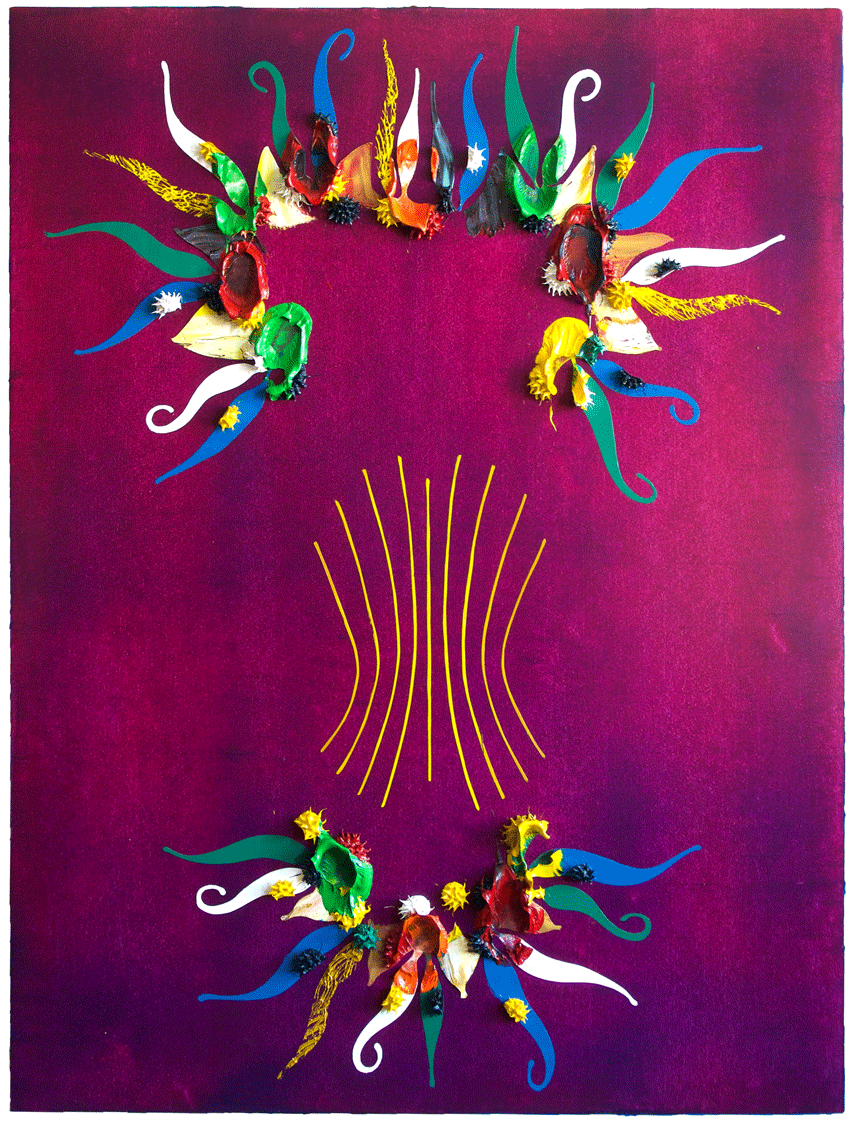
June 3, 2020
Kikuchiyo's Outrage
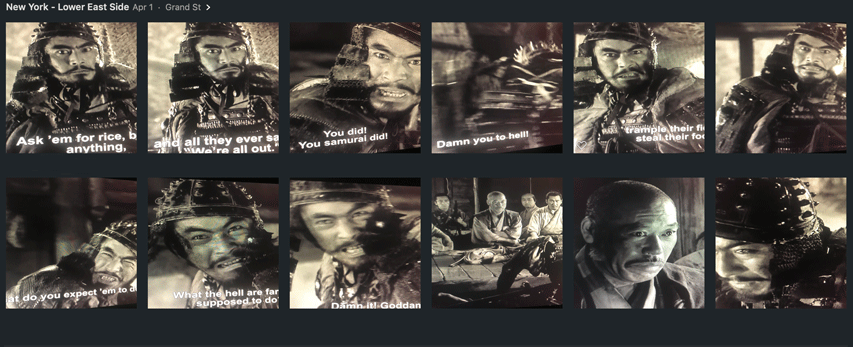
KIKUCHIYO (Laughing bitterly)Well, what do you think farmers are? Saints?KIKUCHIYO suddenly sinks to his knees, bending his head. He begins to sob uncontrollably. Medium shot of the five samurai sitting facing camera, with KIKUCHIYO in the foreground, his head bowed and his shoulders shaking with sobs. A pause, then KAMBEI unfolds his arms and looks down at the palms of his hands.They are the most cunning and untrustworthy animals on Earth.
If you ask them for rice, they'll say they have none. But they have.
They have everything. Look in the rafters, dig in the ground. You'll find it. Rice in jars. Salt. Beans. Saké.
Look in the mountains, hidden farms everywhere. And yet they pretend to be oppressed.
They are full of lies.
When they smell a battle, they make themselves bamboo spears. And then they hunt. But they hunt the wounded and the defeated.
Farmers are miserly, craven...
...mean, stupid... murderous!
You make me laugh so hard I'm crying!
But then... who made animals out of them?You!
You did - you samurai! All of you damned samurai!
And each time you fight you burn villages, you destroy the fields, you take away the food, you rape the women and enslave the men. And you kill them when they resist.
You hear me - you damned samurai?!
This is how I have felt for the past few months. First the virus and now, Helter Skelter.
This is the scene when Kikuchiyo calls bullshit on the hypocrisy of the farmers and samurai. Son of peasants, a self-made warrior in world where the classes are unstrung, he knows both sides of the story, village farmers versus bandits. He is at one with each and both, he knows their nobility and failings, their strengths and weakness.
The village needed to fight fire with fire, but they loathed becoming the monster in order to fight monsters. Ultimately, the village needed people who can match the bandits' violence at their own martial plane, so they decided reluctantly to subcontract Ronin. Since they can't ultimately countenance a culture whose value system is so counter to their own, they felt forced to reject their saviors once the job is done.
I relate to Kikuchiyo because like him, I could be considered a halfbreed. While there are no races but the human race, I am half Malaysian Filipino and half Caucasian American Yanqui. Less than a minority, I'm off the radar. I grew up both in the world of the military as a child of a soldier/airman and came of age within a five year stint as a sailor in the Seventh Fleet; and I grew as an artist: 12 years as an architect in training and coming up on 30 years and counting as a practicing visual artist. I've lived all over the world but I've also put down deep roots in LA, NYC and Catalunya Spain. I know both worlds wherever they are. I love them. I know them all intimately. I know their shortcomings. I know just what kind of wretched they can be. I know them in their glory. I criticize them and defend them from each other.
Civil war sickens me.
From this POV, the villagers are avatars for civilization, too refined as we are in this emergent 21st century to incorporate the coexistence of the warrior mindset required from time to time to defend and ensure its' survival. Kurosawa's cautionary tale in 1954 has been prefigured many times in world literature as far back as the Iliad, a tale as rueful as it was enthralled about war. The rage of Achilles. War is ugly? Absolutely, but let's quote Trotsky: "You may not be interested in war, but war is interested in you." Disavow the complexity and the operation of aggression carries on under a simplistic cover. We become pawns in our own game. Disengage and the powerless are sent into its' maw, war gets exported to subcontractors willing or unwillingly. Our hands, yet stained despite our hollow disavowal.
Is it possible for society to incorporate the ronin worldview? This requires an acknowledgement of the abyss that is never far away. We need to disperse the illusion of paradisiacal security despite our inclination to resist the truth, recognizing that civilization can never be indestructible. Admittedly, dreams are stubborn. They either dissipate or they are broken. Alert readers of this blog will see this argument in my previous discussions about the impact of the end of the Cold War and Francis Fukuyama's "End of History" thesis. Despite the confusion about its' interpretation both by the author and his audience, the abiding theme -that we have arrived at the doorstep of utopia with the apparent triumph of the (NWO) Liberal world order- has been exploded several times since its publication, the so called "War on Terror" being the most conspicuous example. The parallel I see in Seven Samurai is a fancied tragicomedy where the villagers endeavor to deny the existence of bandits, their need of the ronin for salvation... or as a better idealization-cum-realization, that they would attempt to grasp, harmonize and incorporate their own inescapable "ronin-within".
Kikuchiyo's rage is in parallel with mine in present time against a germophobia both real and ideological, an irrational fear of metastasizing Others without end. No where is there undertaken the project of educating the public about the realities of immune health and the need for individuals to take on the responsibility and risk of living life boldly on their own and not surrender this authority to the state. Western healthcare only has half the equation, how to mechanically repair broken bodies, encouraging the growth and health of organic systems is yet alien to us. I despair of the destruction we are now wrecking in the microbial world that our immune systems are in constant need of communion with. And what of ideological phobias? The understanding that the banishment of racism requires the widespread view that racism can only be diminished when we accept that there exists in reality only a singular, whole human race and we are all one, rendering racists as the twisted outliers they really are. All portraits are self portraits. We all have logs of our own manufacture in our own eyes. We can't permit the pyromaniacs among us to disingenuously 'fight fire with fire". Succumb to blind emotion and you get led by the nose. Convulsive virtue signaling won't placate the ever-so-thirsty guillotine, as the latter stages of the French Revolution teaches us. The madness of individuals is not isolated from the madness of entire societies and the schizophrenia spreading world wide can only be countered by a civilizational cognitive therapy.
It was Kambei who unfolded his arms and looked into his hands. It was a samurai, not a villager who self reflected. If there is hope, a silver lining, then we villagers might might find the samurai within and be able to ruminate on this. We could have an opportunity to reflect on our own denial and culpability as the tide of derangement recedes in coming months.
What a slender, slender reed!
